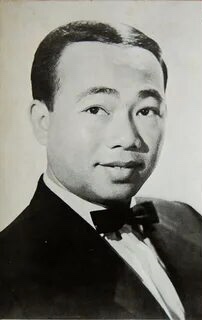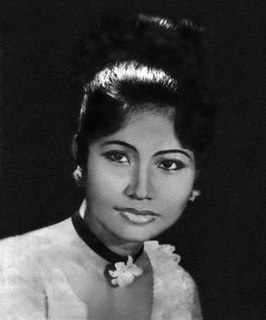
A kick is a physical strike using the leg, in unison usually with an area of the knee or lower using the foot, heel, tibia (shin), ball of the foot, blade of the foot, toes or knee. This type of attack is used frequently by hooved animals as well as humans in the context of stand-up fighting. Kicks play a significant role in many forms of martial arts, such as capoeira, kalaripayattu, karate, kickboxing, kung fu, MMA, Muay thai, pankration, pradal serey, savate, sikaran, silat, taekwondo, vovinam, and Yaw-Yan. Kicks are a universal act of aggression among humans.
Articles related to Cambodia and Cambodian culture include:

Sinn Sisamouth was an influential and highly prolific Cambodian singer-songwriter from the 1950s to the 1970s.

Ros Serey Sothea was a Cambodian singer. She was active during the final years of the Sangkum Reastr Niyum period and into the Khmer Republic period. She sang in a variety of genres; romantic ballads emerged as her most popular works. Despite a relatively brief career she is credited with singing hundreds of songs. She also ventured into acting, starring in a few films. Details of her life are relatively scarce. She disappeared during the Khmer Rouge regime of the late 1970s but the circumstances of her fate remain a mystery. Norodom Sihanouk granted Sothea the honorary title "Queen with the Golden Voice."

Throughout Cambodia's long history, religion has been a major source of cultural inspiration. Over nearly three millennia, Cambodians have developed a unique Cambodian culture and belief system from the syncreticism of indigenous animistic beliefs and the Indian religions of Buddhism and Hinduism. Indian culture and civilization, including its languages and arts reached mainland Southeast Asia around the 1st century AD.

Pradal Serey or Kun Khmer is an unarmed martial art and combat sport from Cambodia. It is a martial art practiced by young, athletic people. The official Khmer name of the sport is Kbach Kun Pradal Khmer. In Khmer, pradal means fighting or boxing and serey means free. Thus, pradal serey may be translated as "free fighting" or "free boxing". The sport consists of stand up striking and clinch fighting where the objective is to knock an opponent out, force a technical knockout, or win a match by points.

Bokator is an ancient battlefield martial art used by ancient Khmer military groups. It is one of the oldest existing fighting systems originating from Cambodia.

Khmer traditional wrestling is a folk wrestling style from Cambodia. It has been practiced as far back as the Angkor period and is depicted on the bas-reliefs of certain temples. The earliest form of Khmer traditional wrestling was called Maloyuth. Maloyuth was created in 788 A.D. by Brahmin Timu. It evolved to the current form of wrestling, Cham Bab, in the 8th century. Although predominantly a male sport today, Khmer wrestling was once practiced by both sexes as female wrestlers are also displayed on the Banteay Srei temple.

Cambodia has increasingly become involved in sports over the last 30 years.

Nimit is a sangkat of Krong Paoy Paet in Banteay Meanchey Province in north-western Cambodia. Before the establishment of Krong Paoy Paet, it was a khum of Ou Chrov District.

The following outline is provided as an overview of and topical guide to Cambodia:

Kbach kun dambong veng is the term for a Cambodian martial art based on the long staff. The term "dambong" means "staff" in the Khmer language and the term "veng" means "long". Translated literally it means "the art/martial skill of the long staff." The term is also used in the phrase "land of the lost staff", Battambang. In the town of Battambang there is a big statue of 'Grandfather Dambong' holding the lost staff. It is based on different mae(s) which can be imagined as a Khmer version of kata(s).

Muay Lao is a traditional unarmed martial art from Laos. It is similar to Muay Thai from Thailand, Pradal Serey from Cambodia, and Tomoi from Malaysia. It incorporates punches, kicks, elbow, and knee strikes. Historians believe Muay Lao originated from Isan or Cambodia. Muay Lao was an event at the 2009 Southeast Asian Games in Vientiane.

The Khmer National Unity Front (KNUF), also known as the Tiger Liberation Movement and Tiger Head Movement or Khmer National Liberation Front, is a Cambodia-based domestic terrorist group whose objective is to violently oust Vietnamese influence from within the Cambodian government. The KNUF was founded by Sok Ek and receives its "Tiger" nicknames from its symbol, which features three tiger heads. Like the Cambodian Freedom Fighters, the KNUF is reportedly dependent on foreign aid. The group is blamed for two foiled bomb attacks against the Cambodian government's:
Dhani Tackles the Globe is an American documentary television series hosted by NFL linebacker Dhani Jones of the Cincinnati Bengals, currently airing on the Travel Channel; the series followed Jones around the globe as he learned how to play international sports and simultaneously explored the culture of each location. It was cancelled after two seasons.
Thun Sophea is a retired professional kickboxer from Svay Rieng, Cambodia. He is the 2006 Cambodian Television Network Traditional Khmer Kickboxing champion.
The traditional martial arts of the Mainland Southeast Asia are related to one another, and as a group to Indian martial arts.

Ranini Cundasawmy from Mauritius is a Mauritian Muay Thai, Savate and Kun Khmer fighter. Winner of several national and world championships.

The Khmer Power Party is a Cambodian pro-American political party founded on 18 March 2010 by Cambodian American Sourn Serey Ratha. It did not officially register until March 2015. The party is in favor of abolishing the monarchy, and establish a second Khmer Republic government.
Cambodian rock of the 1960s and 1970s was a thriving and prolific music scene based in Phnom Penh, Cambodia, in which musicians created a unique sound by combining traditional Cambodian music forms with rock and pop influences from records imported into the country from Latin America, Europe, and the United States. U.S. armed forces radio that had been broadcast to troops stationed nearby during the Vietnam War was also a primary influence. This music scene was abruptly crushed by the Khmer Rouge communists in 1975, and many of its musicians disappeared or were executed during the ensuing Cambodian genocide. Due to its unique sounds and the tragic fate of many of its performers, the Cambodian rock scene has attracted the interest of music historians and record collectors, and the genre gained new popularity upon the international release of numerous compilation albums starting in the late 1990s.























